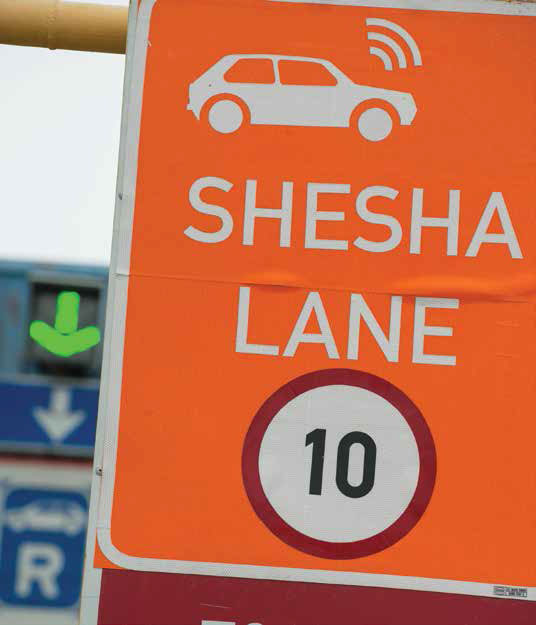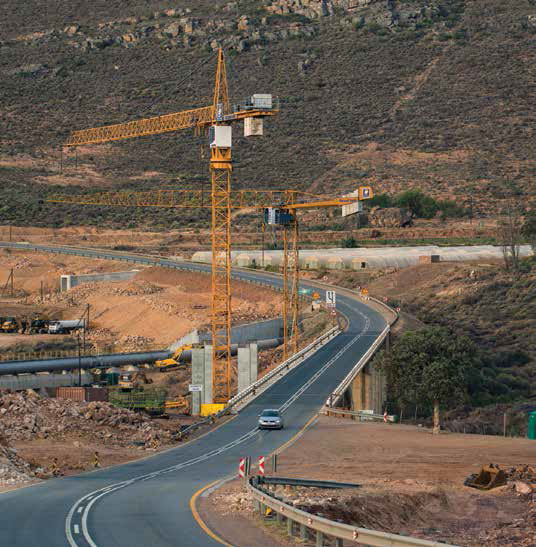A tag can get
you everywhere
Road users on the country’s toll
road network continue to enjoy the
benefits of an automated electronic
payment system.
Alex van Niekerk, SANRAL Manager of Toll & Traffic, said: “A single account can be registered and the same tag, linked to this account, works at all toll plazas, irrespective who operates of the toll plaza.”
The fully interoperable system was introduced by the national roads agency two years ago and has proven to be a major success.
“We are very pleased with the growth and uptake of electronic toll transactions across all toll plazas that were previously operated manually. The average number of toll transactions done electronically has grown from a zero base to above 20%,” Van Niekerk said.
The transition from manual to electronic toll systems is aligned with road users’ expectations for improved service and efficiency.
Most don’t want to delay their journey when making toll payment at a conventional toll facility. A system of electronic toll collection has been developed over the last decade that allows road users to move through the toll plaza without delay.
Automated electronic toll payment is an efficient, fair and sustainable method of collecting tolls. Among its benefits are improved speed and
Alex van Niekerk, SANRAL Manager of Toll & Traffic, said: “A single account can be registered and the same tag, linked to this account, works at all toll plazas, irrespective who operates of the toll plaza.”
The fully interoperable system was introduced by the national roads agency two years ago and has proven to be a major success.
“We are very pleased with the growth and uptake of electronic toll transactions across all toll plazas that were previously operated manually. The average number of toll transactions done electronically has grown from a zero base to above 20%,” Van Niekerk said.
The transition from manual to electronic toll systems is aligned with road users’ expectations for improved service and efficiency.
Most don’t want to delay their journey when making toll payment at a conventional toll facility. A system of electronic toll collection has been developed over the last decade that allows road users to move through the toll plaza without delay.
Automated electronic toll payment is an efficient, fair and sustainable method of collecting tolls. Among its benefits are improved speed and

efficiency of traffic
flow, as well as the convenience of road
users and a reduction of the overall
journey time. It increases the potential
throughput of a conventional toll lane threefold. This reduces the need for toll
plaza expansions.
And it has become a global trend with
South Africa at the forefront.
Internationally, electronic toll collection
systems are not necessarily homogenous in a single country. In the US, for example,
there are various electronic toll collection
technologies deployed that require road
users to set up multiple accounts with
different toll companies and to install
multiple tags in their vehicles.
Useful info for road users
- For a detailed list of all toll plazas where automated electronic toll payment will be accepted, please visit www.sanral.co.za/e-toll
- Signs at the plaza will indicate which lane can be used to pay with a tag
- If a ‘tag accepted’ sign is displayed on the approach to the toll plaza and lanes are not individually marked, it means all lanes accept tags
- Reduce speed when entering the toll plaza area
- Select a lane that accepts SANRAL tags as a method of payment
- Maintain a car-length following distance to avoid payment for a vehicle in front
- If a tag is detected, it will emit
one or more beeps depending on
the account status:
1 beep = payment successful
2 beeps = low balance warning
4 beeps = account suspended (ie no funds in account) - Ensure that there are sufficient funds in the toll account to accommodate the costs of all toll plazas en route
- Note that payments made into the toll account may take up to five days to reflect, if not made online on the account website (www.sanral.co.za/e-toll) or at a SANRAL Customer Service Centre. Booms will not open if the funds in the toll account are less than the amount due at the specific toll plaza. It is also possible to link your account to an automated top-up, by linking your account to a conventional bank account or credit card
- In the event of double billing, for example if the tag appears not to have been read and cash is paid, the slip produced must be kept safe, should there be any disputes at a later stage
Motorists who need help in planning
their journey can contact our
Customer Services at 0800 726 725,
visit one of our centres or email us
on info@sa-etoll.co.za

National
roads
report card
roads
report card
The September report by the South
African Institution of Civil Engineers
(SAICE) on the status of public
infrastructure in the country is a cause
for concern. It painted a bleak picture
of the general level of infrastructure
maintenance and contains a warning:
there is a danger of collapse.
But there are exceptions. SANRAL’s
roads are one of these. So are heavyhaul
freight lines, the Gautrain rail lines
and airports under the control of the
Airports Company of South Africa.
The primary road network, controlled
by SANRAL was graded B, meaning it
is “fit for the future”, or to give the full
SAICE-description: “Infrastructure is in
good condition and properly maintained.
It satisfies current demands and is
sufficiently robust to deal with minor
incidents.”
The SAICE report points to
possible stresses, said SANRAL’s
Communications Manager, Vusi Mona.
It underlines SANRAL’s retention of its
high level of professional engineering
expertise and high standard of
maintenance of its road network, but
our national roads did not achieve an
A-grading, because of the incorporation of a few provincial roads that are in
poor condition. Mona said it does point
out the need for adequate, dedicated
funding.
The vast majority of SANRAL’s
funding comes from National Treasury,
while tolling on some 13% of the roads,
partly as a result of public-private
partnerships, looks after the rest.
“The fact is simply that SANRAL’s
taking on of provincial roads has not
been accompanied by a sufficient
increase in funding,” Mona said. “The
allocated and expected funding from
the national fiscus means SANRAL
cannot take on more than another
3 000km of provincial roads, as
highlighted in our recent long-term
strategy, Horizon 2030. The expected
increase of the network by another
15 000km to 35 000km has therefore
been mooted.
“We are happy with the SAICEgrading,
but are very aware of the fact
that the national road network is the
artery of the country’s economy and it
needs constant upgrading, expansion
and maintenance, which underlines
SAICE’s point that adequate, dedicated
funding is a necessity,” he said.